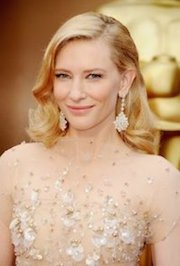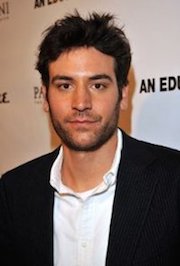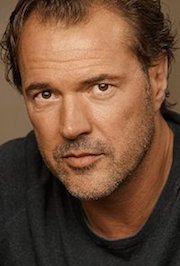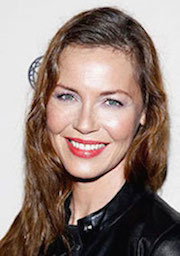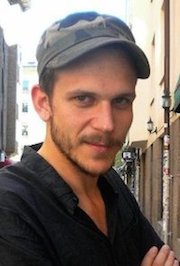Who did it? Nietzsche-inspired philosopher and physician Friedrich Ritter? His patient turned mistress, Dore Strauch? Pipe-smoking former bureaucrat, Heinz Wittmer? Wittmer’s pregnant hausfrau, Margret? The gun-toting Baroness Eloise von Wagner? Or one of her two manservant-lovers, Philippson or Lorenz?
Mums the word from Directors Dayna Goldfine and Dan Geller. They invite you to draw your own conclusions in this intriguing true-life game of Clue. The structurally innovative documentary uses archival film footage, still photographs and first-hand accounts to reimagine unsolved true crimes and mysteries that transpired on the remote island of Floreana in the Galápagos archipelago back in the early 1930’s. Journals for the characters are voiced by an outstanding cast that includes Cate Blanchett, Thomas Kretschmann, Josh Radnor, Diane Kruger, Sebastian Koch, and Connie Nielsen. The historical narrative is counterpointed with interviews from present day island inhabitants, to paint a picture of life in paradise or life in hell, depending on one’s perspective.
The Galápagos islands were made famous by Charles Darwin in his collected writings about the wildlife there that formed the basis for his theory of evolution and natural selection. Floreana Island is one of twenty-one remote islands in the archipelago off the west coast of Ecuador. Even today, Floreana remains eerily undeveloped.
It is curious indeed that three such different groups of German expats would choose to settle on Floreana Island to start a new life? First to arrive on the scene in 1929, were Friedrich and Dore, dubbed by the international press as “The Adam and Eve of the Galapagos.” Inspired by the articles that he read about the doctor and his mistress, out of concern for the health of his fourteen year old son, and trepidation regarding the German economy, Heinz Wittmer convinced his new wife Margret to leave everything behind to begin again on Floreana Island where they fancied themselves, “The Swiss Family Robinsons of the Galapagos.” Baroness von Wagner came to the island with big dreams of constructing the Hacienda Paradiso, a luxury hotel for passing millionaires. It is regrettable that three such incompatible groups came to settle in such close proximity to one another. What was supposed to be a refuge for each of the three groups of settlers became something more akin to the living hell of Sartre’s No Exit, than a biblical Eden.
As director, Geller remarks, “There is this deep, primal, tribal-notion of the small, self-sufficient unit, which is how we originated as a species. The Galapagos Affair is Lord of the Flies and Survivor.”
Geller and Goldfine are the Emmy-award winning director/producers whose work of the past two decades is likely familiar from such great documentaries as Something Ventured (2011), Ballets Russes (2005), Now and Then: From Frosh to Seniors (1999), Kids of Survival: The Art and Life of Tim Robbins + K.O.S (1996), and Isadora Duncan: Movement from the Soul (1988).
I had the pleasure of speaking with Dayna Goldfine and Dan Geller in San Francisco, where they are based, about the making of The Galapagos Affair: Eden Came to Satan — paradise found and lost, and who done it.

Photo courtesy of Chris Hardy and Zeitgeist films.
Sophia Stein: Your documentary may be the first film ever made about the Galapagos islands that does not feature the story of Darwin?
Dayna Goldfine: To get to film on the Islands, you have to get permission from the National Park. When we went into their offices and tried to explain to them that we were going to film some of the animals, but that actually our film was about the people on the island — they thought we were insane. They kept asking over and over again, “You want to do what?!”
Dan Geller: If you know of the Islands at all, you know about Darwin. We’ve got the giant Galapagos tortoise as the observing eye that periodically shows up in the movie, just starring out from the screen at the audience. But ultimately we thought, you bring a little Darwin in, you have to bring in a lot, and that’s not what the movie is about. So Darwin went bye-bye.
Dayna: The whole movie, in a way, is about survival of the fittest. We felt like even if we never invoked Darwin’s name, he is there hovering over the whole story. If you really think about it, at the end of the day, those who survived were the people who were most fit for that environment.
Sophia: What were the adaptive traits that the survivors brought to that situation?
Dan: On an island where scarcity rules the day, there is the notion of self-reliance. But then there is the other aspect about being “the most socially adaptive.” Now does that mean that you are able to roll with what is going down on this island as conflicts arise? Or does that just mean you are the most able to get rid of everybody else? Hopefully, once you have watched the movie, you begin to see who, in this tripartite drama, might be responsible for getting rid of whom.
Dayna: I do feel that ultimately, the people that survived, were the people that could cooperate. Not all of the people on the island, could. Maybe the survivors were slightly less egotistical then some of the others.
Sophia: Who lives on Floreana Island today?
Dan: Unlike on Santa Cruz Island, where there are quite a few people living, Floreana is only about seventy-five people today. There are two families primarily, that each have little commercial operations – hotel or farming. There are the people who work either at the little hotel or on the farm. There is a tiny school for the kids, and a Naval Base that consists of a hut. That’s about it. So there is not much there. Most of that island is not arable or habitable. It is deprived of water to the extent that it would be very difficult for a bigger population to build up.
Dayna: The people who came to the island of Floreana in the 1920’s and 1930’s when our story takes place chose that island because it did have a few streams of water — streams, not rivers, and certainly not enough fresh water to supply more than a handful of people with enough good drinking water. It is ironic, these islands are surrounded by water, salt-water. So, when you live on them, you might still die of thirst.
Sophia: The making of the film was a 15 year journey?
Dan: The actual hands-on making of the film was probably about seven years total. I am a cinematographer and Dayna records sound, and normally, we just do that for ourselves as producer-directors. But in 1998, our friend hired us to come down to the Galapagos Islands to shoot an educational project. That’s when we tripped across this story and met Margret Wittmer, who was the last of the eye-witness participants-protagonists-antagonists. The idea got planted in our heads, without any notion of how one would actually turn it into a movie.
Dayna: When you go through life as a documentary filmmaker, you hear about stories and think, “Oh, my God, that would be an incredible film! … But how could I actually do it?” In this case, we wondered how can we tell this story without any survivors and without doing any reenactments.
Dan: If you were to film recreations for this story, you would have to recreate so much of it, it would become a fiction film. We don’t make those kinds of movies. So we just parked the idea until 2001, when we heard about this archive of film footage moldering at the University of Southern California.
Dayna: By that time, we were already making Ballets Russes, and we didn’t want to interrupt making that film. So we got in touch with the archive and started the process.

Photo courtesy of Zeitgeist films.
Sophia: What was it like to see all that archival footage for the first time?
Dan: We had to take this footage from Los Angeles to Monaco Labs in San Francisco to have it cleaned, restored and transferred. It wasn’t cheap; it cost thousands of dollars. We were taking the risk that there might be nothing salvageable in the footage. But in fact, there was plenty there. To see that footage unspool … It was jaw-dropping. The footage was shot across four or five years. To watch these islanders progress through various stages of health and decrepitude, was phenomenal in terms of providing us with the resources to start assembling a movie. It was more than we ever could have imagined. We were so lucky that we had it restored when we did because in just a couple of more years, I believe, it all would have been shot to pieces, with no way to salvage it.
Danya: The archive included still photos and journals. Among his many avocations, Captain Allan Hancock was an amateur scientist. Luckily for the world really, he chose to use his vast amounts of money to do some interesting things. He built the largest ocean-faring scientific laboratory at the time. Starting in 1931, he took groups of top-notch scientists that he recruited from around the world – from the California Academy, the Smithsonian, and academies in Europe — down the coast of the Americas aboard his ship, the Velero III. He brought a 35 mm cameraman to film it all. He also was a very accomplished cellist, and most of the scientists on the boat played instruments.
Dan: When Dore and Friedrich board the Velero during Hancock’s first visit, there is that shot of a trio playing that we subtitled “The Captain Allan Hancock Orchestra.” They made their own concerts because there was no radio out there at sea.
Sophia: In the film, Dore sends letters to friends and family back in Germany, and these letters are leaked to the press. How did those letters become public?
Dayna: Their families and their friends, in many ways, betrayed them. Basically, for centuries, on Floreana, there was this barrel that whalers and people who had stopped off on the island used to deliver messages.
Dan: Just a little barrel on a stake, in a little bay, which acquired the nickname Post-Office Bay.
Dayna: Supply ships would come, sometimes only once a year. They would pick up correspondence from this barrel, and eventually, it would make its way to Europe. It wasn’t until Allan Hancock actually brought back copies of newspapers and magazines that had been published, that Friedrich and Dore realized, “Wow, our story has gotten out into the world.”
Sophia: So you had this great footage to work with. Then, how did you approach writing the script?
Dan: We wrote it together, along with our producer Celeste Schaefer Snyder, who has worked with us for many years, and our phenomenal editor, Bill Weber. At first, we tried to tackle everything at once: the murder-mystery story and the story of the islanders who were still alive and living on Santa Cruz Island in the Galapagos. It was just too much. We were getting lost. So then we decided, let’s just get the murder mystery part down and then build upon that story. We knew the chronology of the murder-mystery. We had lots to choose from — Dore’s memoirs, Margret’s memoirs, John Garth — the biologist traveling aboard the Velero III, his journals. Slowly but surely we assembled that script. Then we sat back and thought, O.k., where are the stories that echo — the search for Paradise of the original Floreana settlers, the dissatisfaction, the difficulties getting along with people. How are their concerns mirrored in stories from settlers who arrived on Santa Cruz Island around the same time or who were born there a few years later? Where would that counter-point expand the vision of the movie? That was the second phase. The third phase was to figure out the balance between these story elements. We were experimenting. At that point, we would organize little work-in-progress screenings with trusted colleagues to figure out where it was working and where it was not. So the process was iterative.
Dayna: It was so much trial and error. Each of us played a couple of the roles – Bill and Dan and Celeste and me.
Dan: We read the parts out loud, as temporary voiceovers.
Dayna: Can you imagine, Cate Blanchett coming and listening to me, playing Dore Strauch. Not one of my better days.
Sophia: Scoring Cate Blanchett to voice Dore Strauch, that is a coup. How did that happen?
Dayna: Cate probably took mercy on us and said, “Oh, my God, Dayna can’t play that role. I’d better come in.”
Dan: It was a total fluke. A wonderful fluke that Patrick McIntyre, whom we had known from the Ballets Russes movie when he worked at The Australian Ballet in Melbourne, wound up as CEO of the Sydney Theatre Company where Cate Blanchett and her husband, Andrew Upton, were artistic directors. When Cate was coming to San Francisco to shoot Blue Jasmine with Woody Allen, Patrick made the introduction. We hit it off immediately. Months later, mostly at the urging of our casting director, we worked up the nerve to ask Cate (through Patrick actually), if she would consider voicing the role of Dore. Cate had seen the movie at our house when she was shooting with Woody Allen, and she liked it, so she was happy to help out. Once Cate came on-board, then we could get other phenomenally talented actors, as well. Her participation gave the film credibility all of a sudden.
The Cast of Voices, “The Galapagos Affair: Satan Came to Eden” —
Cate Blanchett (Dore Strauch), Thomas Kretschmann (Friedrich Ritter), Josh Radnor (John Garth)
Diane Kruger (Margret Wittmer), Sebastian Koch (Heinz Wittmer), Connie Nielson (The Baroness)
Gustaf Skarsgård (Rolf Blumberg).
Sophia: Were you present as directors at those recording sessions with the actors?
Dayna: Diane Kruger and Josh Radnor are based in Los Angeles, so we flew to L.A. for their sessions. When Cate said she would play Dore, which is really the biggest role in the film — because we had some really dear friends in Australia, and we love excuses to go to Sydney, we flew down there for the session. So that was the one, really extravagant thing we did. We recorded with Connie Nielsen in the Bay area. Gustaf Skarsgård, Thomas Kretschmann and Sebastian Koch were all working in Europe. So either we would find a recording studio in the city where they were working (or they would find one for us), and we did those sessions by Skype.
Dan: The wonderful thing about working with actors at this level is that you don’t have to direct very much. It’s just a question of making sure that everyone understands that they are all in the same movie. It was a wonderful surprise to realize that you could record someone in Stockholm, someone else in Sydney, in Los Angeles, and in San Francisco, and they will all sound like they were together!
Dayna: We had never written a script this complicated before. There are so many characters. It is as close to a dramatic fiction film as you could possibly get. It was really like writing a script-script. So there was a lot to learn about that process.
Also, it was about learning how do you write a good mystery script? We spent a lot of time in the very beginning talking about foreshadowing and watching old Alfred Hitchcock movies to see how he does it. You have to give away a certain percent. For example, you probably have to say that someone died right up front to provide enough foreshadowing that you lock the viewer in right away.
In the very, very, very opening lines, Dore reveals that her partner eventually dies. We went back and forth about whether we could actually do that or whether we had to do that. Ultimately, we decided that is a really important piece of foreshadowing so that the audience realizes from the start of the film that there is something that went on here that involved death.
Sophia: Were there additional disappearances that you did not document in the film?
Dan: In the time frame of this story, there were more intrigues, but not more disappearances.
Dayna: The Baroness had more lovers that came and went.
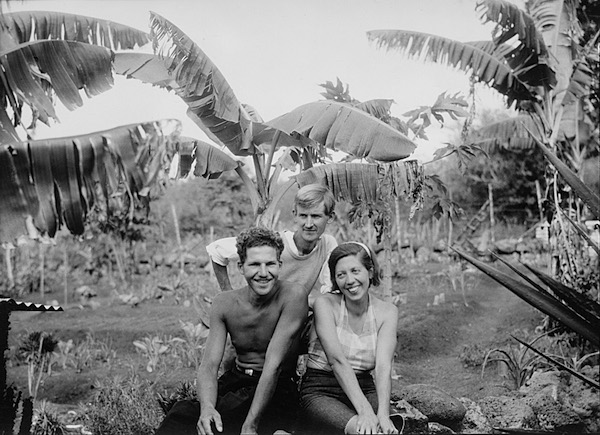
Satan Came to Eden.” Photo courtesy of Zeitgeist films.
Sophia: When you are doing investigative work on a murder mystery, if somebody has a stake in the cover-up, it could make things dangerous. At any time in the making of the film, did you feel that you were in danger?
Dayna: All of the key protagonists were gone.
Dan: That helps!
Dayna: At one point in the film, Margret Wittmer’s great-grandson asks his grandfather and his aunt, “Living on Floreana, weren’t you ever afraid of people?,” and they respond, “There weren’t any people here, so why would we have to be scared of people?!” That that was how I kind of felt, too.
I felt very committed to telling the story as completely as possible, but also telling it as fairly as possible. I didn’t want to pin a murder on someone, just for the sake of doing that.
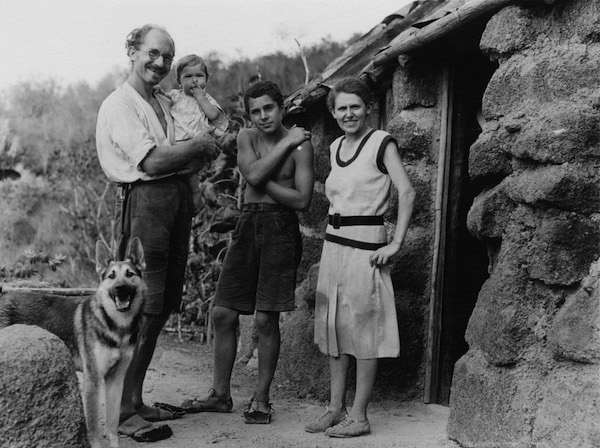
“The Galapagos Affair: Satan Came to Eden.” Photo courtesy of Zeitgeist films.
Sophia: When you began working with the story, Margret Wittmer was still alive. Did you ever have an opportunity to talk to her about the disappearances?
Dan: We only met her one time in 1998. We were told point blank by Miguel Mosquera, who was our National Park Guide on that trip (and whom we subsequently brought on as our island fixer for all our subsequent trips): “You cannot ask the old lady anything about this because she’s my friend. She won’t answer, and you will just make her angry.” At that point, Margret was around ninety-three years old, mostly lucid; she would drift in and out, a little bit. She was telling stories about how Roosevelt had come to the Galapagos and visited her. She was very proud of that.
Then, without any kind of lead in, she just volunteered one phrase — which had only one possible context, which was the murder mystery from those days: “En boca cerrada no entran moscas.” (“A closed mouth attracts no flies.”) The Stanford professor that we were with on that 1998 trip told us how he had taken students down there and Margret similarly in a moment where there was a lull in the conversation just drew her finger across her neck and smiled. Margret played with the notoriety.
Dayna: She absolutely was a very dramatic person. The Baroness had wanted to be the Queen of Floreana, but ironically, Margret was left on the island as the real Queen, and she really bought into that role. People came to the island to see Margret and get her autograph; they bought her book. She loved that notoriety til the day she died.
Dan: Our boat broke down at Floreana Island; we weren’t even supposed to be there that day. So here we were with Margret and we were being served tea and cookies. There is the question of poisonings in the story. Of course, we knew nothing was going to happen to us, but we played it up ourselves, shooting each other little looks of, “Ooo, should we drink the tea? Do you think the cookies are safe?” By the time we learned about the footage at USC, Margret was gone. So we never had a chance to circle back around.
Sophia: You have been quoted as saying that “The story is beyond a ‘Who-done-it?’” that it is about “the perennial search for Paradise.” A lot of the settlers came from Germany during the great depression of the 1930’s and the rise of Hitler, so they were escaping a much harsher reality than the one which they met on the island. Do you know what it entailed for those people to pick up and leave? Did they have to obtain permission from the governments involved?
Dan: The Beer Hall Putsch happened in Germany in 1923, and it was 1929-1931 when everyone started arriving on Floreana. At that point, it was still pretty easy to get out of Germany. The Nazis had not fully come to power yet.
Dayna: These people weren’t Jews. Some people were leaving because their fathers had fought in World War I, and they were prescient that there was another war brewing.
Dan: There was horrible depression-era poverty.
Dayna: Ecuador looked at the Islands, more or less, as penal colonies. Just these lumps of volcanic, uncultivable land.
Dan: They wanted Norwegians to come and live on the islands because there was a potential for developing a fishing industry. They knew that there was an abundance of aquatic life to harvest, but they didn’t have the training for that kind of deep sea fishing or canning. So the Ecuadorian government wanted to attract that expertise to the island.
Danya: Because they did not look at the islands as at all valuable until quite recently, for a long time, they would give any settler who basically stopped in Guayaquil and got permission from the Ecuadorian government the equivalent of approximately 250 acres. You didn’t own it, per se, but you could farm it, and do whatever you wanted with it. Unless you went up into the highlands where you could actually cultivate farms, you were living by the Ocean, and it was quite difficult to survive.
Sophia: Floreanita Wittmer runs Wittmer Lodge, a modest hotel on Floreana today. Have you stayed there?
Danya: We stayed for a week back in 2007.
Dan: It’s not the Ritz, but nothing down there really is. It’s simple. The fun part is that almost everyone who was born into a family that arrived on the islands in the 1920’s, 30’s or 40’s, has retained the cultural meme of the family in which they were raised. Even though it is all part of Ecuador, Floreanita and her daughter are German to the core. So Dinner is at 6:00 pm, and if you arrive for dinner at 6:00 pm, you’re late! You should be there five minutes early. You are served a German meal, and it’s good.
Danya: Back then, the only place to stay was Floreanita’s little hotel, which was basically a handful of cinderblock rooms, and a little shower in each room that was barely ever hot. Now, the Cruz family, who also appear in the film, have started their own competing hotel, the Floreana Lava Lodge. So you can probably imagine how that went over.
Sophia: Oh, boy — Part two!
Danya: Exactly. The Cruz family actually owns the land that Friedrich and Dore lived on and I have seen online ads that read: “Come stay on the island of Floreana in our little cabanas. We’ll have a barbeque up at Ritter’s grave.” Literally! Do a Google search. It’s unbelievable.
Sophia: How did you two become a filmmaking team?
Dan: I was finishing up my graduate thesis work at Stanford in the documentary program when Dayna and I were introduced by a housemate of mine at the time, Terry.
Dayna: After we had been together for a month or two, I realized that what Dan was doing was so much more interesting than what I was doing — which was working for a financial pension consultant. So it wasn’t a hard decision. I went to Dan and sheepishly confessed, “I’ve always had this dream of working with my life’s partner, and what you’re doing seems so incredible, how would you feel about that?” Dan said something which was really hard to hear at that moment, but which was really important: “That would be great, but you need to learn on your own. I don’t want to be your perpetual teacher.” Dan finished his masters thesis, and I started taking classes at De Anza College down in Cupertino. Pretty early on, a friend wrote from Paris and said, there is this great story about Isadora Duncan that you guys should really do. Without thinking much about it — because we say “yes” to things, that’s just how we go through life — we said, “Yes.” It just was this steam-roller that happened. We have pretty much lived in the Bay area ever since we first met.
Dan: With our parrot, Seymour, our cockatoo and two cats. It’s a menagerie.
Dayna: For the making of Frosh, we put all our stuff in storage and moved into a Freshman dorm for nine months. It was so much fun. Those kids are forty-one, forty-two now, and we are still really close with a lot of them. Even Seymour the parrot lived in the dorm.
Dan: He did, that’s true.
Sophia: Do you harbor a vision of retiring in a place like Floreana or Santa Cruz Island in the Galapagos? Is that part of your vision as a couple?
Dayna: I love that question.
Dan: Well, I don’t have a vision of retirement at all. I want to keep making movies. Santa Cruz and Floreana are beautiful, rugged, interesting places. I hope that we can continue to visit them because we have made friends down there. But my personal inkling is to be in a place that has much more in the way of artistic and intellectual foment. I am less of a back to the land person and more of a back to the theatre type.
Dayna: Although, I have to say, all of those people who live on the islands are incredibly intellectual. In the U.S., you grow up assuming that you have to go to school and you should go to college, duh-duh-duh-duh-duh. Well, these kids who were born on Floreana and Santa Cruz were homeschooled, and they are some of the most well-read people I have ever met. They all speak multiple languages. They have all read more important books than I have. So it is actually a very intellectual environment.
Dan is correct, the ballet wouldn’t come and perform there. There’s no movie theatre. But I have to say, Dan and I have different takes on these things. When we went back in 2007 to film and were there for five or six weeks in one fell swoop, I actually got the bug!
Dan: Not for me. No, no, no, no!
Dayna: Dan was terrified. But luckily for Dan, you can’t settle there anymore. The only people that can own land on those islands, are grandfathered in. Not even Ecuadorians can own land there. You have to have been born on the islands. So, it isn’t really a possibility.
Dan: There is one wonderful little moment that happened a couple of years ago when we were filming down there. Ben Pierce, who was a principal dancer at San Francisco Ballet (and who subsequently became a filmmaker), came down to crew with us. We were hanging out with Jacqueline De Roy, one of the protagonists in the movie from Santa Cruz Island, and her daughter Tui. When they found out that Ben was a dancer, they so much wanted to see him do something. The thing about Galapagos generally, is that it is a lava shore, there is not much beach. But right where the De Roy’s live, there is one little spit of beach. The sun was going down, it was almost pitch black, and Ben said, “Come out.” And so Jacqueline and Tui sat down on the sand and in front of them he performed a solo ballet.
Dayna: To no music. So sweet.
Dan: And they were so happy.
Dayna: He said that it was one of his favorite performances that he ever did. Now that I have gotten it mostly under control, my dream would to be able to go back for one month each year.
Dan: That would be beautiful.
Dayna: And revisit our friends. There is just something about being on those islands and hanging with the tortoises and the animals that …
Dan: That is great for me. I’d be happy to do that.
Dayna: Yeah, but probably not to live there.
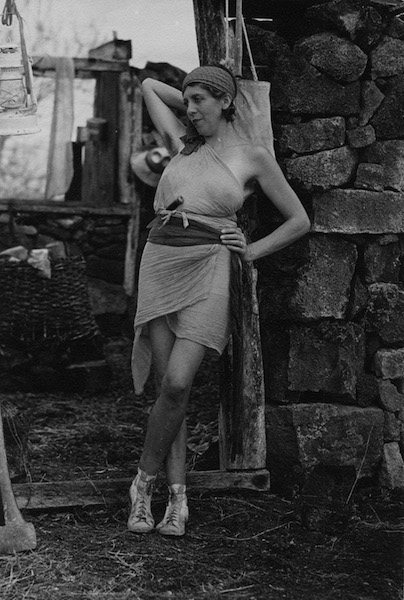
Satan Came to Eden.” Photo courtesy of Zeitgeist films.
Sophia: So, at the end of making this film, do you have a theory that you agree upon about what occurred? Or do you maintain individual takes?
Dan: I think we have different takes. I believe that everyone was complicit in some part of making it happen or covering it up. I don’t know who did what. What I think, depends on the day for me. Not to know is the intrigue of it.
Dayna: The only thing I do feel really deeply, is that the Baroness did not leave the island. In reading as many true crime stories as possible while writing the script, if something was solved, I often would end up feeling like it was so banal, the solving of the mystery had ruined the story for me. Maybe that would be the case with this story too. I love the idea that we put this story out there in the world, and if people like it, audiences will leave the theatre debating amongst themselves.
Dan: At the time of the disappearances, there was a Governor on San Cristobal Island in the Galapagos, and a little army outpost. There was no law on Floreana Island. It was Ritter and Dore, the Wittmer Family, the Baroness and her lovers, period. That was it. Nobody to observe, nobody to make a definitive record, and every reason for people to try to shunt the blame onto each other in their memoirs. Which is kind of terrifying when you think about it. Because if you don’t have some agreed upon structure, then do we devolve quickly into the most base versions of ourselves?
Dayna: Dore has that great line: “It may be that in a wild place like Floreana, the primitive character in each person comes out, so that everybody shows his own true face – a rare sight in this world, and rather disconcerting.”
Top Image: Friedrich Ritter and Dore Strauch, “The Galapagos Affair: Satan Came to Eden.” Photo courtesy of Zeitgeist films.
For more information, see The Galapagos Affair: Satan Came to Eden official website.

